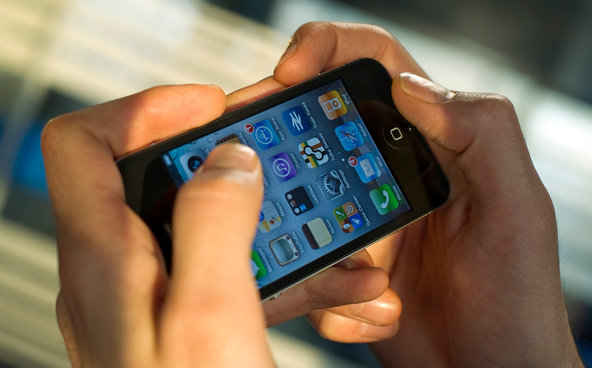 Adrian Dennis/Agence France-Presse — Getty ImagesInstead of going through life staring into a mobile device, people one day may be able to wear a computer.
Adrian Dennis/Agence France-Presse — Getty ImagesInstead of going through life staring into a mobile device, people one day may be able to wear a computer.
Technology often has a way of fixing the problems it creates. Here’s one that needs solving.
The invention of the smartphone has created a world where millions of people stroll through life constantly staring into a mobile device, like Narcissus at the edge of a pond.
I know. I’m one of them.
People are not going to put these devices down in the near future. Realistically, we will become only more absorbed by the Screen. Technology will have to solve this problem. It will do so by creating wearable computers.
Wearable computing is a broad term. Technically, a fancy electronic watch is a wearable computer. But the ultimate version of this technology is a screen that would somehow augment our vision with information and media.
Over the last year, Apple and Google have secretly begun working on projects that will become wearable computers. Their main goal: to sell more smartphones. (In Google’s case, more smartphones sold means more advertising viewed.)
In Google’s secret Google X labs, researchers are working on peripherals that — when attached to your clothing or body — would communicate information back to an Android smartphone.
People familiar with the work in the lab say Google has hired electronic engineers from Nokia Labs, Apple and engineering universities who specialize in tiny wearable computers.
Apple has also experimented with prototype products that could relay information back to the iPhone. These conceptual products could also display information on other Apple devices, like an iPod, which Apple is already encouraging us to wear on our wrists by selling Nanos with watch faces.
A person with knowledge of the company’s plans told me that a “very small group of Apple employees” had been conceptualizing and even prototyping some wearable devices.
One idea being discussed is a curved-glass iPod that would wrap around the wrist; people could communicate with the device using Siri, the company’s artificial intelligence software.
The brain that brings all these things together is the smartphone, which after all is really the first wearable computer. Researchers note that the smartphone is almost never more than three feet away from its user. It is often just inches from the bed during the night as well, and has replaced the alarm clock for many people.
As a result, the smartphone is going to be the hub for our information sharing and gathering. Think of it as a force field that will engulf us wherever we are, transmitting power and Internet access to sensors and screens that are tacked to our clothing.
“Years ago, researchers envisioned these tiny computers transmitting information to the Internet,” said Yael Maguire, a visiting scientist at M.I.T. and Harvard . “It wasn’t what we envisioned, but it happened. It’s called the smartphone.”
Michael Liebhold, a senior researcher specializing in wearable computing at the Institute for the Future in Palo Alto, Calif., predicts that the next step in technology is the blurring of the real and virtual worlds.
Over the next 10 years, he says, he envisions that people will be wearing glasses with built-in screens and, eventually, contact lenses — with working displays.
“Kids will play virtual games with their friends, where they meet in a park and run around chasing virtual creatures for points,” he said.
Fashion will most likely be one of the first disruptions. Imagine teenagers being able to design their own virtual clothing that others wearing heads-up displays can see.
Parents, teachers and friends could be shown entirely different outfits. For example, I could look like a giant pink cat in a bustier to my friends, but my boss would see me in a fancy Italian suit.
At least, I hope that’s what he would see.
The alternative, I’m afraid, might call for a technological solution of its own.
Article source: http://feeds.nytimes.com/click.phdo?i=218e67810dd779519db4a52985a37573